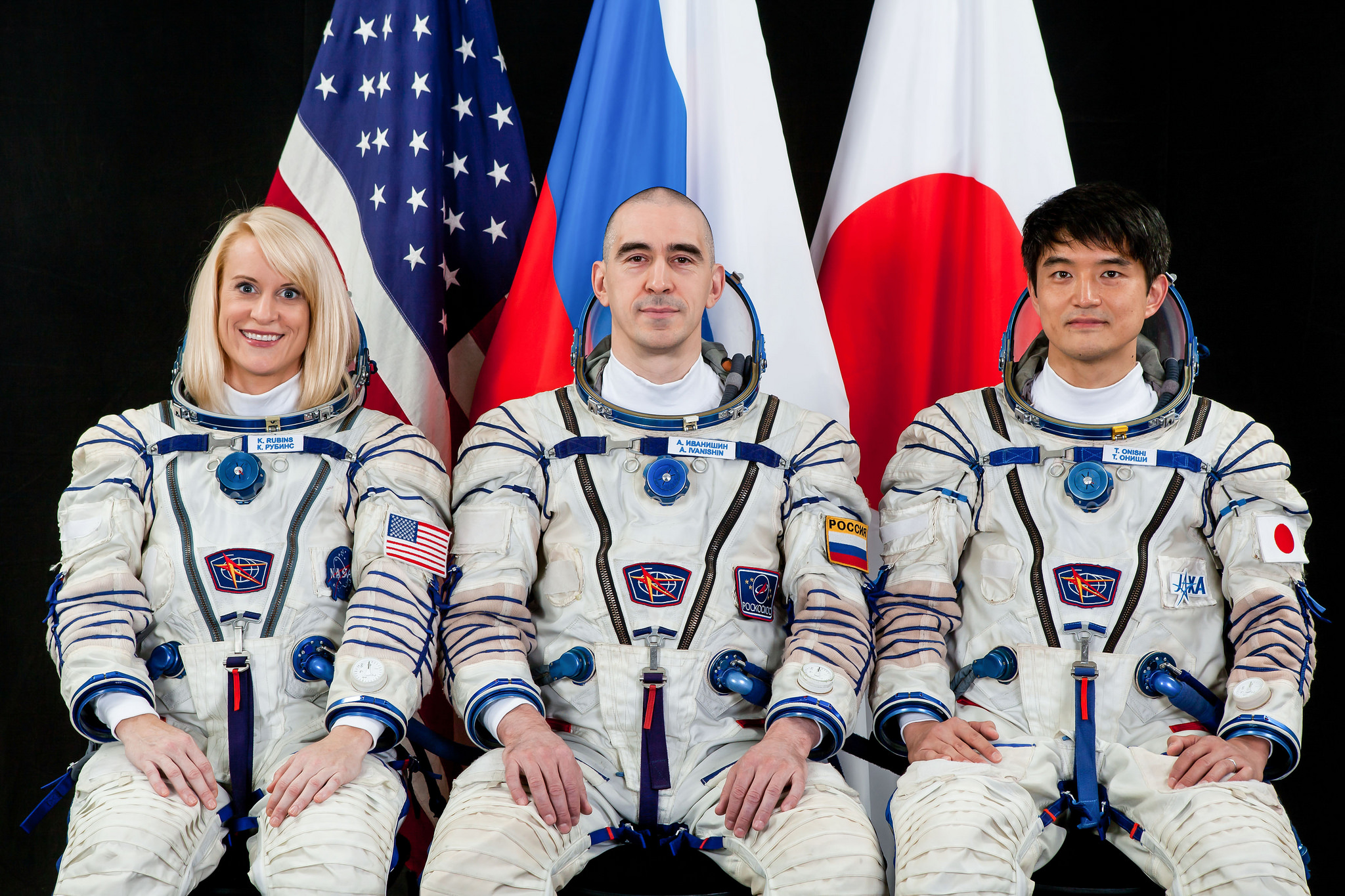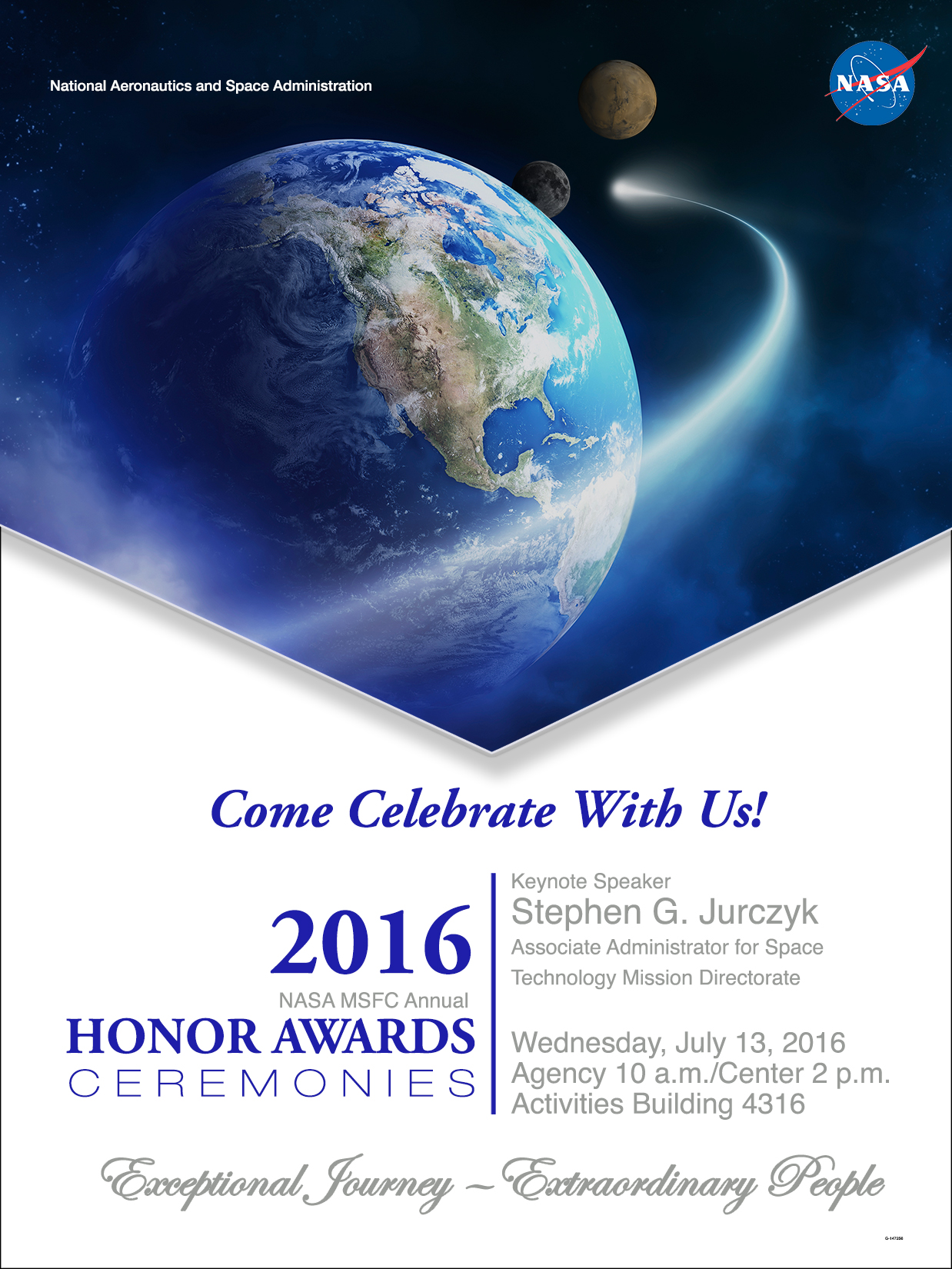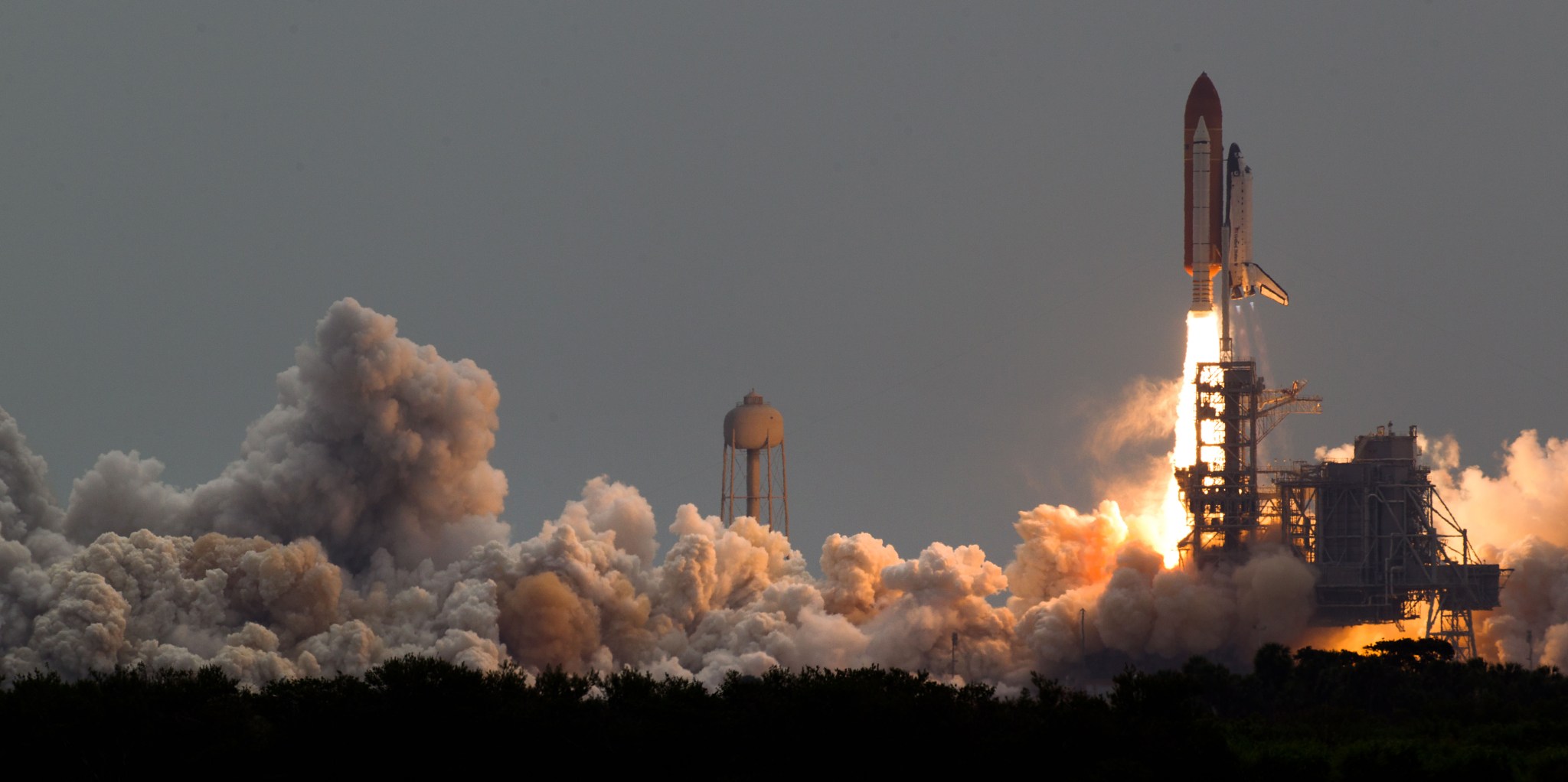In This Week’s Star
- New Space Station Crew Members to Launch July 6 for Two-Day Ride on Upgraded Soyuz
- NASA and Marshall to Recognize Outstanding Team Members at Annual Honor Awards Ceremonies July 13
- NASA’s Juno Spacecraft in Orbit Around Mighty Jupiter
- This Week in NASA History: Final Space Shuttle Mission Launches — July 8, 2011
- Booster Test and Rocket Hardware Featured on ‘This Week @NASA’
- Obituaries
New Space Station Crew Members to Launch July 6 for Two-Day Ride on Upgraded Soyuz
NASA astronaut Kate Rubins, cosmonaut Anatoly Ivanishin of the Russian space agency Roscosmos, and astronaut Takuya Onishi of the Japan Aerospace Exploration Agency will launch July 6 at 8:36 p.m. CDT (7:36 a.m. Baikonur time, July 7) from the Baikonur Cosmodrome in Kazakhstan bound for the International Space Station. All three will spend approximately four months on the orbiting laboratory, returning to Earth in October. Live launch coverage will broadcast on NASA-TV and streamed live on NASA.gov at 7:30 p.m.
The trio will travel in an upgraded Soyuz spacecraft, testing modified systems for two days — and 34 Earth orbits — before docking to the space station’s Rassvet module at 12:12 a.m. July 9. NASA TV coverage of docking will begin at 10:30 p.m. July 8. The normal trip to the station takes approximately six hours and four orbits.
Hatches between the Soyuz and station will be opened about 2:50 a.m. July 9, when the newly arrived crew will be greeted by NASA astronaut Jeff Williams and Flight Engineers Oleg Skripochka and Alexey Ovchinin of Roscosmos. NASA-TV coverage of hatch opening and welcoming ceremonies will begin at 1:30 a.m.
The Expedition 48 crew members will continue the several hundred experiments in biology, biotechnology, physical science and Earth science currently under way and scheduled to take place aboard humanity’s only orbiting laboratory.
The agency’s streaming channel and the full NASA TV schedule can be found here.
NASA and Marshall to Recognize Outstanding Team Members at Annual Honor Awards Ceremonies July 13
By Brian C. Massey
NASA and the Marshall Space Flight Center will recognize more than 280 Marshall employees, contractors and teams during Annual Honor Awards ceremonies in the Activities Building, Building 4316, on July 13. All Marshall team members are invited to attend.
Award presentations will be made during two ceremonies — agency-level Honor Awards at 10 a.m. and center-level Honor Awards at 2 p.m. The morning ceremony will recognize those who have made significant achievements to NASA’s mission at an agency level. The afternoon ceremony will recognize those who have made outstanding mission contributions to Marshall.
Stephen G. Jurczyk, NASA associate administrator for Space Technology Mission Directorate, will be the keynote speaker at both ceremonies. Jurczyk and Marshall Center Director Todd A. May will present the awards to the honorees.
Announcing the agency-level awards will be Tereasa H. Washington, director of Marshall’s Office of Human Capital; John H. Honeycutt, manager of the Space Launch System Program Office; and Nelson C. Parker, deputy manager of the Chief Engineers Office.
The center-level awards will be announced by Jody A. Singer, Marshall Center deputy director; Lewis Wooten, director of the Missions Operations Laboratory; Michael L. Tinker, acting center chief technologist, Office of the Director; and Garry Lyles, chief engineer of the Space Launch System Program Office.
James E. Turner, associate director for Technical Management in Marshall’s Engineering Directorate, will emcee.
For a list of the NASA Honor Awards, click here.
For a list of the Marshall Honor Awards, click here.
NASA’s Juno Spacecraft in Orbit Around Mighty Jupiter
After an almost five-year journey to the solar system’s largest planet, NASA’s Juno spacecraft successfully entered Jupiter’s orbit during a 35-minute engine burn. Confirmation that the burn had completed was received on Earth at 10:53 p.m. CDT, July 4.
“Independence Day always is something to celebrate, but today we can add to America’s birthday another reason to cheer — Juno is at Jupiter,” said NASA Administrator Charlie Bolden. “And what is more American than a NASA mission going boldly where no spacecraft has gone before? With Juno, we will investigate the unknowns of Jupiter’s massive radiation belts to delve deep into not only the planet’s interior, but into how Jupiter was born and how our entire solar system evolved.”
Confirmation of a successful orbit insertion was received from Juno tracking data monitored at the navigation facility at NASA’s Jet Propulsion Laboratory as well as at the Lockheed Martin Juno operations center in Littleton, Colorado. The telemetry and tracking data were received by NASA’s Deep Space Network antennas in Goldstone, California, and Canberra, Australia.
“This is the one time I don’t mind being stuck in a windowless room on the night of the Fourth of July,” said Scott Bolton, principal investigator of Juno from Southwest Research Institute in San Antonio. “The mission team did great. The spacecraft did great. We are looking great. It’s a great day.”
Preplanned events leading up to the orbital insertion engine burn included changing the spacecraft’s attitude to point the main engine in the desired direction and then increasing the spacecraft’s rotation rate from 2 to 5 revolutions per minute to help stabilize it.
The burn of Juno’s 645-Newton Leros-1b main engine began on time at 10:18 p.m. decreasing the spacecraft’s velocity by 1,212 miles per hour and allowing Juno to be captured in orbit around Jupiter. Soon after the burn was completed, Juno turned so that the sun’s rays could once again reach the 18,698 individual solar cells that give Juno its energy.
“The spacecraft worked perfectly, which is always nice when you’re driving a vehicle with 1.7 billion miles on the odometer,” said Rick Nybakken, Juno project manager from JPL. “Jupiter orbit insertion was a big step and the most challenging remaining in our mission plan, but there are others that have to occur before we can give the science team the mission they are looking for.”
Over the next few months, Juno’s mission and science teams will perform final testing on the spacecraft’s subsystems, final calibration of science instruments and some science collection.
“Our official science collection phase begins in October, but we’ve figured out a way to collect data a lot earlier than that,” said Bolton. “Which when you’re talking about the single biggest planetary body in the solar system is a really good thing. There is a lot to see and do here.”
Juno’s principal goal is to understand the origin and evolution of Jupiter. With its suite of nine science instruments, Juno will investigate the existence of a solid planetary core, map Jupiter’s intense magnetic field, measure the amount of water and ammonia in the deep atmosphere and observe the planet’s auroras. The mission also will let NASA take a giant step forward in our understanding of how giant planets form and the role these titans played in putting together the rest of the solar system. As the primary example of a giant planet, Jupiter also can provide critical knowledge for understanding the planetary systems being discovered around other stars.
The Juno spacecraft launched on Aug. 5, 2011, from Cape Canaveral Air Force Station. JPL manages the Juno mission for NASA. Juno is part of NASA’s New Frontiers Program, managed at NASA’s Marshall Space Flight Center for the agency’s Science Mission Directorate. Lockheed Martin Space Systems in Denver built the spacecraft. The California Institute of Technology in Pasadena manages JPL for NASA.
For more information on the Juno mission, click here, or follow the mission on Facebook and Twitter.
This Week in NASA History: Final Space Shuttle Mission Launches — July 8, 2011
This week in 2011, after 30 years and 135 missions, the final mission of NASA’s Space Shuttle Program launched. The morning after launch, NASA Marshall Space Flight Center team members delivered a special video wake-up message to the STS-135 crew. The video was recorded two weeks earlier in the Morris Auditorium, Building 4200. The NASA History Program is responsible for generating, disseminating and preserving NASA’s remarkable history and providing a comprehensive understanding of the institutional, cultural, social, political, economic, technological and scientific aspects of NASA’s activities in aeronautics and space. For more pictures like this one and to connect to NASA’s history, visit the History Program’s webpage. (NASA)
Booster Test and Rocket Hardware Featured on ‘This Week @NASA’
The firing of a booster and delivery of an upper stage test article, both for NASA’s Space Launch System, are featured in the latest edition of “This Week @NASA,” a weekly video program broadcast nationwide on NASA-TV and posted online.
On June 28, a booster motor for the SLS rocket was test fired for a major two-minute full-duration qualification ground test at the test facilities of Orbital ATK Propulsion Systems in Promontory, Utah. Engineers will evaluate test data on the motor’s performance using cold propellant, the steering operation of its redesigned nozzle and other operational data to help qualify the booster for flight. This is the last time the booster will be fired in a test environment before it’s used for the first uncrewed test flight of SLS with NASA’s Orion spacecraft, known as Exploration Mission-1, in late 2018.
Also, a key piece of SLS hardware arrived at NASA’s Marshall Space Flight Center to prepare for its part in a series of upcoming tests. The interim cryogenic propulsion stage is the liquid oxygen/liquid hydrogen-based system that will give Orion the big, in-space push needed to fly beyond the moon before it returns to Earth. The ICPS test article will be stacked on a test stand with other structural hardware that make up the upper portion of the SLS rocket, and subjected to forces similar to those experienced in flight. The testing is designed to ensure the structural integrity of the hardware is not compromised by those conditions.
View this and previous episodes at “This Week @NASA” or at https://www.youtube.com/user/NASAtelevision.
Obituaries
Donald G. Davis, 84, of Auburn, Alabama, died June 24. He retired from the Marshall Center in 1988 as an aerospace engineer.
Michael T. Borelli, 91, of Huntsville, died June 29. He retired from the Marshall Center in 1981 as an aerospace engineer.
Amy M. McGowan, 41, of Hartselle, Alabama, died July 3. She began working at Marshall in 1994 as a management support assistant, where she was still employed at the time of her death. She is survived by her husband, Brandon McGowan.
Merlyn M. Masters, 74, of Huntsville, died July 4. He retired from the Marshall Center in 1999 as a contract specialist. He is survived by his wife, Ann F. Masters.




























